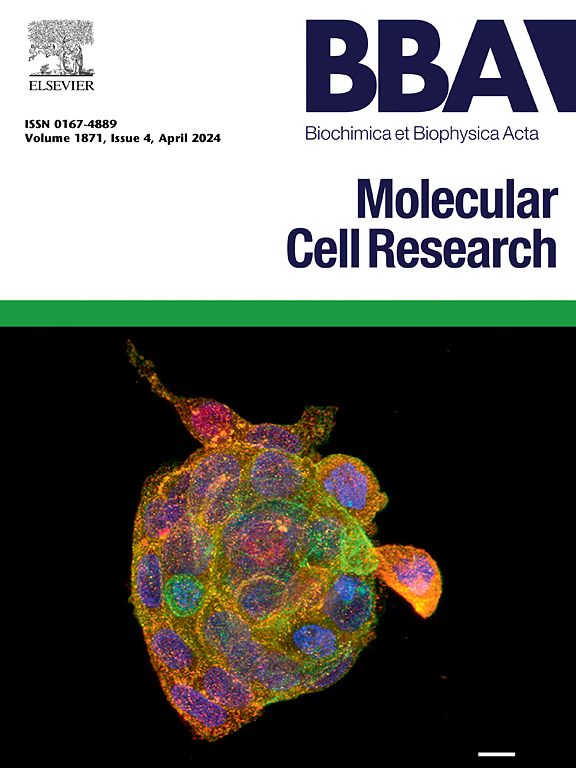GlycoRNA-L and glycoRNA-S mediate human monocyte adhesion via binding to Siglec-5
IF 3.7
2区 生物学
Q1 BIOCHEMISTRY & MOLECULAR BIOLOGY
Biochimica et biophysica acta. Molecular cell research
Pub Date : 2025-07-01
DOI:10.1016/j.bbamcr.2025.120017
引用次数: 0
Abstract
It was recently reported that RNAs can be glycosylated, and such glycosylated RNAs (referred to as glycoRNAs) are located on the outer cell surface. We here reported that there are two forms of glycoRNAs, named as glycoRNA-L and glycoRNA-S, robustly expressed in human monocytes. We verified that the glycoRNA-S specifically detected in human monocytes is synthesized by enzyme-catalyzed conjugation, but not artificial products of labelling probe. RNase-treatment removed both glycoRNA-L and glycoRNA-S, suggesting that they are localized on cell surface. Removing glycoRNAs significantly suppressed the interaction of human monocytes with endothelial cells, suggesting that glycoRNAs mediate human monocyte adhesion. Using flow cytometry, immunoprecipitation and northern blotting we identified Siglec-5 as the binding receptor of glycoRNAs. Siglec-5 is expressed in human endothelial cells but presented on endothelial cell surface when endothelial cells are activated. We observed that glycoRNA-L was heavily labeled with sialic acid, whereas glycoRNA-S was heavily labeled with N-acetylgalactosamine and N-acetylglucosamine. Together, these results demonstrate that two forms of glycoRNAs exist in human monocytes, which may play significant role in controlling the interaction of human monocytes and endothelial cells and contribute to the pathogenesis of inflammatory diseases.
GlycoRNA-L和glycoRNA-S通过与siglece -5结合介导人单核细胞粘附
最近有报道称rna可以被糖基化,这种糖基化的rna(称为glycoRNAs)位于细胞外表面。我们在这里报道了两种形式的glycorna,分别命名为glycoRNA-L和glycoRNA-S,在人类单核细胞中强烈表达。我们证实了glycoRNA-S在人单核细胞中特异性检测是通过酶催化偶联合成的,而不是标记探针的人工产物。rnase处理去除了glycoRNA-L和glycoRNA-S,表明它们定位于细胞表面。去除糖cornas可显著抑制人单核细胞与内皮细胞的相互作用,提示糖cornas介导人单核细胞粘附。通过流式细胞术、免疫沉淀和northern blotting,我们鉴定出siglece -5是glycoRNAs的结合受体。siglece -5在人内皮细胞中表达,但在内皮细胞被激活时出现在内皮细胞表面。我们观察到glycoRNA-L被唾液酸大量标记,而glycoRNA-S被n -乙酰半乳糖胺和n -乙酰氨基葡萄糖胺大量标记。综上所述,这些结果表明,人单核细胞中存在两种形式的glycoRNAs,它们可能在控制人单核细胞与内皮细胞的相互作用中发挥重要作用,并参与炎症性疾病的发病机制。
本文章由计算机程序翻译,如有差异,请以英文原文为准。
求助全文
约1分钟内获得全文
求助全文
来源期刊
CiteScore
10.00
自引率
2.00%
发文量
151
审稿时长
44 days
期刊介绍:
BBA Molecular Cell Research focuses on understanding the mechanisms of cellular processes at the molecular level. These include aspects of cellular signaling, signal transduction, cell cycle, apoptosis, intracellular trafficking, secretory and endocytic pathways, biogenesis of cell organelles, cytoskeletal structures, cellular interactions, cell/tissue differentiation and cellular enzymology. Also included are studies at the interface between Cell Biology and Biophysics which apply for example novel imaging methods for characterizing cellular processes.

 求助内容:
求助内容: 应助结果提醒方式:
应助结果提醒方式:


